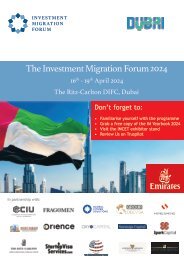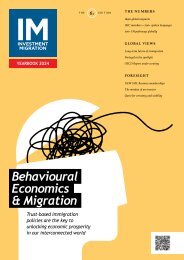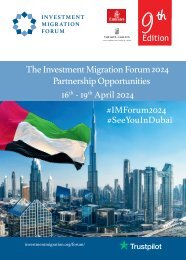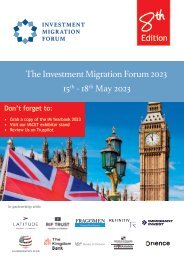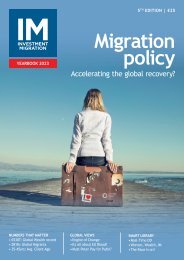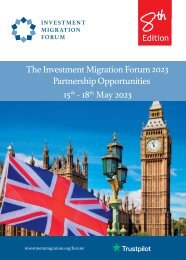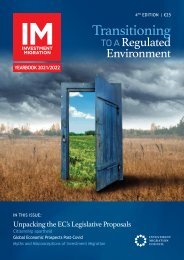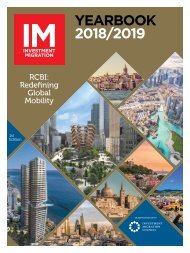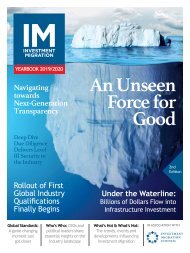IM Yearbook 2020/21
Born from the need for a global, credible, “go-to” publication, the 3rd IM Yearbook offers valuable access to a prime target audience of top industry influencers, decision makers, and the foremost referral network to the world’s most influential Investment Migration programmes: Government officials such as Heads of CIU’s, policy makers, academics, migration agents, law firms, wealth managers, financial advisors, real estate developers, and international firms involved in investment migration.
Born from the need for a global, credible, “go-to” publication, the 3rd IM Yearbook offers valuable access to a prime target audience of top industry influencers, decision makers, and the foremost referral network to the world’s most influential Investment Migration programmes: Government officials such as Heads of CIU’s, policy makers, academics, migration agents, law firms, wealth managers, financial advisors, real estate developers, and international firms involved in investment migration.
Create successful ePaper yourself
Turn your PDF publications into a flip-book with our unique Google optimized e-Paper software.
I think smaller<br />
projects are<br />
beneficial<br />
for the investor<br />
because they can<br />
easily get their arms<br />
around them.”<br />
explains Kraft. This offering, he says, “is<br />
very attractive to Indian EB-5 investors<br />
who – more than many other nationalities<br />
– like the value of entrepreneurship”.<br />
FPP today works in 40 different<br />
countries and expanded its footprint<br />
years ago. “We kind of anticipated the<br />
retrogression issue with Chinese nationals,<br />
and we are active around the world,” says<br />
Kraft. Last year, his firm also started offering<br />
services for E-2 treaty country investors and<br />
investors born in non-treaty countries who<br />
can apply for this type of visa after obtaining<br />
citizenship in the Caribbean country of<br />
Grenada. “This year, due to Covid-19, we<br />
spent a lot of time on rethinking projects<br />
and also upgrading our sales process. We<br />
are scaling up, bringing in people with<br />
industry experience, to better serve our<br />
investors. In 20<strong>21</strong>, things will start going back<br />
to normal, and we will hit the road running<br />
with a really good track record and some<br />
very exciting projects to present globally.”<br />
Driving EB-5 Forward<br />
Part of Kraft’s mission throughout the<br />
years has been to continuously improve<br />
EB-5. For the past four years, he has<br />
been serving as President of Invest in the<br />
USA (IIUSA), the global industry trade<br />
association of the EB-5 Regional Centre<br />
Programme, which has been suffering<br />
from a series of short-term extensions and<br />
a constantly growing quota backlog. “The<br />
programme has just been extended right<br />
through to December <strong>2020</strong>. I think that’s<br />
the 18 th extension over the past four to five<br />
years,” says Kraft. EB-5, he mentions, is<br />
supported by Democrats and Republicans.<br />
“This means there isn’t much of a problem<br />
to get both parties to re-authorise a<br />
programme, but to get them to agree to<br />
a new programme is a different story.”<br />
Although America’s EB-5 programme<br />
has been the most successful immigrant<br />
investor programme in the world, its overall<br />
economic impact on the US economy is<br />
still small, he admits. EB-5 could be of<br />
tremendous benefit to the US economy in<br />
the post-Covid-19 recovery; however, two<br />
things are important for EB-5 to realise<br />
its true potential, he says. The first is to<br />
distinguish between main investors and<br />
family members, as currently the cap of<br />
10,000 visas is still interpreted in a way<br />
that family members are counted toward<br />
the annual visa allocation. “A proper<br />
interpretation of investor visa units would<br />
increase the programme by two-thirds,<br />
which then can bring in $9 billion per<br />
year and create at least 288,000 jobs per<br />
year, so over the course of five years, we are<br />
talking some very significant numbers.”<br />
The second is a long-term authorisation<br />
for about six years. “The extensions aren’t<br />
much of a problem because everybody<br />
understands that the programme just<br />
gets rolled over, but it would still be nice<br />
to have the regional centre programme<br />
in place for a longer period of time.”<br />
Drop in Demand<br />
Rather than a general overhaul, EB-5<br />
has seen incremental change, with some<br />
new regulations coming into effect at the<br />
end of 2019. The definition and selection<br />
of “targeted employment areas,” also<br />
known by its acronym TEA, has been<br />
tightened to ensure that investment is truly<br />
being channelled into areas with high<br />
unemployment. In addition, the investment<br />
threshold for the TEA option has been<br />
raised from $500,000 to $900,000. Has<br />
this affected demand? Yes, says Kraft. “It<br />
had a negative effect. And just when the<br />
market would have adjusted to the higher<br />
number, Covid-19 hit. We all know that<br />
it’s difficult over zoom and phone calls to<br />
really move the programme forward.”<br />
However, he’s convinced that there will<br />
be a return to normality in 20<strong>21</strong>, although<br />
he admits that the US is in crisis mode –<br />
the presidential election, racial turmoil<br />
and the impact of the coronavirus on the<br />
country’s health all add up. “Right now,<br />
politics is as aggressive as I’ve ever seen<br />
it in my life time. There is certainly a lot<br />
going on, but I am not sure whether this<br />
has diminished immigration interest in<br />
the US because interest in our projects is<br />
still very high from around the world.” He<br />
believes the US is still the top destination<br />
for migrants and will emerge stronger<br />
from the current pandemic crisis.<br />
EB-5 can be a powerful tool to help<br />
stimulate economic development and<br />
job creation. “EB-5 has already proven<br />
effective during an economic recession.<br />
The programme has generated $20.6<br />
billion in investment and created or<br />
saved 730,000 jobs between the fiscal<br />
years 2008 and 2015 when the US was<br />
recovering from the financial crisis.”<br />
New Opportunities<br />
Kraft has extensive experience in running<br />
manufacturing operations, but does he<br />
believe manufacturing could play a greater<br />
role in the EB-5 programme? “I think<br />
manufacturing is getting stronger in the<br />
US, but the problem with manufacturing<br />
is that it is more subjected to global<br />
disruptions and tougher to manage. A<br />
hotel project, for instance, is fairly static<br />
and predictable, and even if the business<br />
fails, you still have the tangible real estate<br />
asset to sell. In the case of manufacturing<br />
operations, many times you are dealing<br />
with lease facilities, so if the product<br />
is out of favour, management makes a<br />
mistake or there is a global interruption<br />
in terms of trade, there is not much left.”<br />
He believes hotels will always be a great<br />
option for EB-5 due to their high potential<br />
for job creation. But they may also be<br />
opportunities in distribution centres on<br />
the back of increased e-commerce activity.<br />
Infrastructure investment is also high on<br />
his agenda. IIUSA is currently working<br />
with US policymakers on defining what<br />
qualifies as infrastructure in terms of EB-5<br />
investment. “The issue with infrastructure<br />
is if it’s just road and bridges – how do you<br />
repay investors? There is really no revenue,<br />
so it would require a government bond or<br />
similar. I think infrastructure investment<br />
is really a big need and a good opportunity<br />
in the US. We are not quite there yet<br />
but it’s definitely an area to watch.”<br />
Kraft is optimistic about the future as<br />
the recent changes to the EB-5 programme<br />
had brought it back to the original idea<br />
of driving economic development in<br />
areas that needed it most. “That’s a very<br />
good change for the long-term, and it<br />
will pave the way for EB-5 to play a key<br />
role in the post-Covid-19 recovery.”<br />
Investment Migration <strong>Yearbook</strong> 2O2O/2O<strong>21</strong> 61




